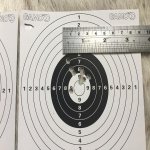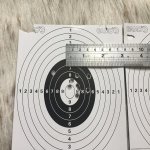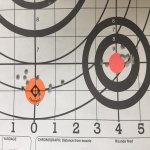Fair enough, I didn't believe it either when I first started glassing it through my scope. I initially thought maybe three had landed, and the rest were off the paper. Believe it or not, the SK on left shot much better at 50 than the force and this was me being really confused while doing 100-yard testing. All I can do is present the information if you choose to believe it or not is up to you!
It's necessary to put this in some perspective. It's said that at 100 yards the Eley Force was so good that it shot a ten-shot group somewhere between .750" and .875" (or 3/4" - 7/8") -- based on the grid on the target being 1" apart. It's hard to imagine .22LR ammo being less accurate at a shorter distance, therefore the Eley must have shot awfully tight groups at 50 yards. Nevertheless, at 50 yards, the SK (Standard Plus? Rifle Match?) shot even better than the Eley Force. The SK must have shot almost uniquely remarkable groups at 50 yards to do better than the ammo that shot the .875" ten-shot group at 100.
A 50 yard group would be more than twice as small as a 100 yard group. In other words, to use an example, if a group was .500" at 50 yards, it can be expected to be more than doubled in size at 100 yards. A loose rule of thumb for .22LR shooting holds that as distance doubles group size triples. In reverse, as distance is halved, group size would be a third of what it is at the greater distance. As a result, a .500" group shot at 50 yards can be expected to be closer to 1.5" rather than 1" at 100. The corollary is that a 1" group at 100 yards will be closer to .33" at 50. To be sure, this is not necessarily a physical law that applies accurately each and every time, but it is a general rule of thumb that is a very reasonable approximation.
The Eley Force ten-shot-group at 100 yards is ostensibly very close to .875" would have to be at least .4375" at 50 yards -- and by all reason even less. To apply the rule of thumb, that Eley Force ten-shot-group at 50 yards would be .292" (or 7.42mm). But even simply halving the group size allegedly achieved at 100 yards, a ten-shot-group at 50 yards that measured .4375" (or 11.1mm) is still very good indeed.
In fact it is good enough to be considered quite a good factory test target achieved with the barreled action in a specially-made testing vise. To give some perspective, Anschutz tests its rifles in an indoor range with the barreled action in a vise. The minimum standard for accuracy is a ten-shot group at 50 yards that measures no more than 18mm (.709"). Anschutz 54 action single shot match rifles do much better than meet that standard. Keep in mind, of course, that these tests are done indoors with no wind whatsoever and with the barreled action in a vise.
To sum up, the Eley Force is alleged to have produced a ten-shot-group at 100 yards that is about .875" -- a size which would still be quite remarkable for a five-shot-group at that distance. At 50 yards this ammo would shoot a ten-shot-group no more than .4375" but very likely even better, perhaps as small as .292". Furthermore, the SK ammo shot so well at 50 yards that it was even better than the Eley Force, which itself is quite extraordinary considering how well the Eley had to shoot. Unfortunately the SK did not hold much accuracy at 100, but that in itself is not surprising as not all ammo remains consistent as distance increases.
If the results claimed above are genuine, then it suggests one or more of several possibilities. First, it's a one-off, hardly ever to be reproduced with that rifle again, sort of like picking the right lotto numbers for next Saturday night. Second, the rifle is very unusual in that it is a one-of-a-kind factory barreled Savage Mark II capable of extraordinary accuracy. Third, there is a force at work here that engendered a confluence of incredible fortune in shooter, rifle, and ammo. Fourth, there is a mistake made somewhere. Unfortunately, the alternative is that it didn't happen as described.

















































































